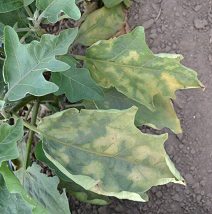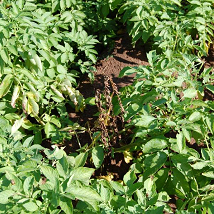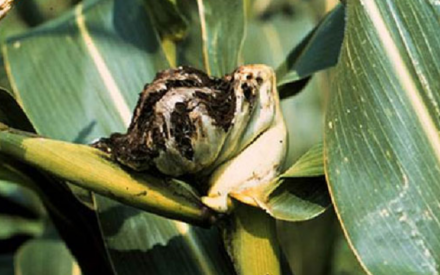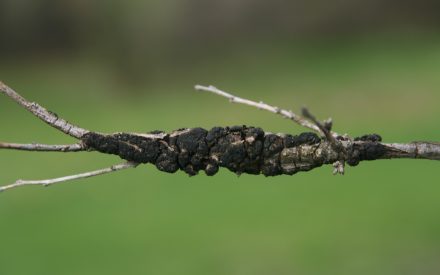
What is Verticillium wilt?
Verticillium wilt is a typically fatal disease that affects a wide range of vegetable crops in Wisconsin. Vegetables commonly and severely affected by Verticillium wilt include tomato, potato, pepper, eggplant, cucumber, muskmelon, pumpkin and watermelon. Other vegetables such as asparagus, bean, beet, broccoli, Brussels sprouts, cabbage, cauliflower, celery, chive, collards, garlic, kale, kohlrabi, leek, lettuce, mustard, onion, parsley, peas, radish, rutabaga, spinach and turnip are susceptible to Verticillium wilt, but show less severe symptoms. Some vegetables, such as sweet corn are immune to the disease. Many woody and herbaceous ornamentals are also susceptible to Verticillium wilt of trees and shrubs.
What does Verticillium wilt look like?
Initial symptoms of Verticillium wilt include sudden yellowing of foliage, typically first appearing on one side of a plant. These leaves then wilt and die. Oftentimes, symptoms mimic the natural aging process of leaves. Eventually however, the entire plant becomes affected and dies. By peeling away the outer layers of affected branches or vines, you may observe brown streaking in the vascular (water-conducting) tissue. Vascular browning is common in tomato and potato plants.
Where does Verticillium wilt come from?
Verticillium wilt is caused primarily by two fungi, Verticillium dahliae and Verticillium albo-atrum. These fungi are commonly found in Wisconsin soils. V. dahliae and V. albo-atrum have wide host ranges including many common weeds, such as ragweed, cocklebur, and velvetleaf. Susceptible plants and their debris can serve as an overwintering site for these fungi. In potato, root lesion nematodes (Pratylenchus spp.) can contribute to the development of Verticillium wilt. However, the role of these nematodes in Verticillium wilt development in other vegetable crops is not well understood.
How do I save a plant with Verticillium wilt?
Vegetables infected with Verticillium cannot be cured and will eventually die. However, you can extend the life of infected plants by fertilizing and watering them properly. Fertilization should be based on a soil nutrient test and should be tailored to the specific vegetables being grown. Most vegetables require approximately one inch of water per week. If natural rains are not sufficient, then supplemental water should be applied using a soaker or drip hose.
How do I avoid problems with Verticillium wilt in the future?
Do not repeatedly grow crops that are highly susceptible to Verticillium wilt in the same area of your garden each year. Try to rotate highly susceptible crops with other less susceptible crops. See Using Crop Rotation in the Home Vegetable Garden for details on this process. Also, try to plant vegetable varieties that are resistant to Verticillium wilt. In particular, many modern tomato varieties are resistant to the disease. Watch for varieties with the letter “V” after the variety name. If Verticillium wilt resistant varieties of your favorite vegetables are not available, select varieties that mature early. Early maturing varieties are more likely to produce usable vegetables before they eventually succumb to the disease than late maturing varieties.

In addition to using resistant varieties, try to eliminate sources of Verticillium in your garden. Keep broadleaf weeds under control, as these plants are often susceptible to Verticillium wilt and can serve as a reservoir for the fungus. Do not use mulches that may have been produced from trees (e.g., maple and ash trees) that are susceptible to Verticillium wilt, and immediately collect and discard leaves that have fallen from symptomatic trees. Also, remove and discard debris from susceptible vegetable plants. Burn (where allowed by local ordinance) or landfill infected plants and infested plant debris. Do not bury or compost these materials. Finally, decontaminate any gardening items (e.g., shovels, hoes, plant stakes, pots, working surfaces, etc.) that may have come into contact with Verticillium to prevent spread of the fungus. Rinse these items with water to remove clinging soil, then treat them for at least 30 seconds with a 10% bleach solution or (preferable for metal tools due its less corrosive properties) 70% alcohol (e.g., rubbing alcohol, certain spray disinfectants). If you use bleach, be sure to thoroughly rinse and oil metal tools after gardening to prevent rusting.
For more information on Verticillium wilt:
Contact the University of Wisconsin Plant Disease Diagnostics Clinic (PDDC) at (608) 262-2863 or pddc@wisc.edu.
Authors: Ken Frost* and Brian Hudelson, UW-Madison Plant Pathology
Last Revised: 03/02/2024
D-number: D0122
* Completed as partial fulfillment of the requirements for Plant Pathology 875 – Plant Disease Diagnostics Clinic Internship at the University of Wisconsin Madison.
References to pesticide products in this publication are for your convenience and are not an endorsement or criticism of one product over similar products. You are responsible for using pesticides according to the manufacturer’s current label directions. Follow directions exactly to protect the environment and people from pesticide exposure. Failure to do so violates the law.
Thanks to Rosemarie Bugs, Amanda Gevens and Chris Parise for reviewing this document.
A complete inventory of UW Plant Disease Facts is available at the University of Wisconsin-Madison Plant Disease Diagnostics Clinic website: https://pddc.wisc.edu.
Send a Plant Sample for Analysis
Be cautious when self-diagnosing plant health issues. Very few diseases can accurately be diagnosed by eye.
Contact the UW Plant Disease Diagnostics Clinic (PDDC), and for a small fee, clinic staff can examine a plant, determine the cause of the disease/disorder, and provide advice on how to control or prevent the issue.
Download Article





 Vegetable Disease Quick Reference
Vegetable Disease Quick Reference Powdery Scab
Powdery Scab Tizón Tardío (Late Blight)
Tizón Tardío (Late Blight) Strategies for Identifying and Managing Plant Diseases
Strategies for Identifying and Managing Plant Diseases


